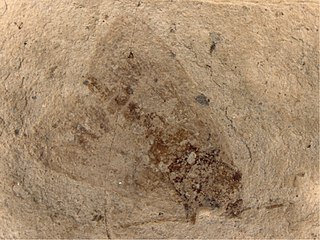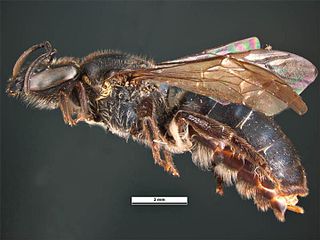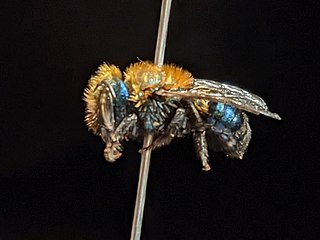Cockerell is a surname, and may refer to:

Alice Eastwood was a Canadian American botanist. She is credited with building the botanical collection at the California Academy of Sciences in San Francisco. She published over 310 scientific articles and authored 395 land plant species names, the fourth-highest number of such names authored by any female scientist. There are seventeen currently recognized species named for her, as well as the genera Eastwoodia and Aliciella.

Theodore Dru Alison Cockerell (1866–1948) was an entomologist and systematic biologist who published nearly 4,000 papers, some of them only a few lines long. Cockerell's speciality was the insect order Hymenoptera, an area of study where he described specimens from the United States, the West Indies, Honduras, the Philippines, Africa, and Asia. Cockerell named at least 5,500 species and varieties of bees and almost 150 genera and subgenera, representing over a quarter of all species of bees known during his lifetime. In addition to his extensive studies of bees, he published papers on scale insects, slugs, moths, fish scales, fungi, roses and other flowers, mollusks, and a wide variety of other plants and animals.

The Bombini are a tribe of large bristly apid bees which feed on pollen or nectar. Many species are social, forming nests of up to a few hundred individuals; other species, formerly classified as Psithyrus cuckoo bees, are brood parasites of nest-making species. The tribe contains a single living genus, Bombus, the bumblebees, and some extinct genera such as Calyptapis and Oligobombus. The tribe was described by Pierre André Latreille in 1802.

Palaeovespa is an extinct genus of wasp in the Vespidae subfamily Vespinae. The genus currently contains eight species, five from the Priabonian stage Florissant Formation in Colorado, United States two from the middle Eocene Baltic amber deposits of Europe. and one species from the late Paleocene of France.
Anthidium scudderi is an extinct species of mason bee in the Megachilidae genus Anthidium. The species is solely known from the late Eocene, Chadronian stage, Florissant Formation deposits in Florissant, Colorado, USA. Anthidium scudderi is one of only four extinct species of mason bees known from the fossil record, and with Anthidium exhumatum, one of two species from the Florissant Formation.

Paleolepidopterites is a collective genus of fossil moths which can not be placed in any defined family. The included species were formerly placed in the leaf-roller family Tortricidae and are known from fossils found in Russia and the United States. The collective genus contains three species: Paleolepidopterites destructus, Paleolepidopterites florissantanus, and Paleolepidopterites sadilenkoi, formerly placed within the genera Tortrix and Tortricites respectively. The three species were formally redescribed and moved to the new collective genus by Heikkilä et al (2018).

Hydriomena? protrita is an extinct species of moth in the family Geometridae, and possibly in the modern genus Hydriomena. The species is known from late Eocene, Priabonian stage, lake deposits of the Florissant Formation in Teller County, Colorado, United States. It was first described by Theodore Dru Alison Cockerell in 1922.

Felimare porterae is a species of sea slug, a dorid nudibranch, a shell-less marine gastropod mollusk in the family Chromodorididae. It was named by Theodore Dru Alison Cockerell in honor of his wife Wilmatte Porter Cockerell.
Protostephanus is an extinct genus of crown wasp in the Hymenoptera family Stephanidae known from an Eocene fossil found in the United States of America. The genus contains a single described species, Protostephanus ashmeadi placed in the stephanid subfamily Stephaninae.
Charlotte Cortlandt Ellis was an American amateur plant collector active in New Mexico. She discovered several plant taxa and collected some 500 plant specimens.
Megachile kirbyana is a species of bee in the family Megachilidae. It was described by Theodore Dru Alison Cockerell in 1906, from a specimen collected in Fremantle.

Calyptapis is an extinct bombini genus related to bumblebees with one described species Calyptapis florissantensis. It is known only from the Late Eocene Chadronian age shales of the Florissant Formation in Colorado. The genus and species were described by Theodore Dru Alison Cockerell in 1906.
Primula rusbyi is a species of Primula. A common name is Rusby's primrose.
Calliopsis puellae is a species of bee in the family Andrenidae. It is found in Central America and North America.
The Porter's miner bee is a species of miner bee in the family Andrenidae. It is found in North America. It was first described by Theodore Dru Alison Cockerell in 1900 and named after the collector of the type specimen Wilmatte Porter.

Bombus irisanensis is a rare species of bumblebee endemic to Luzon in the Philippines.

Lasioglossum halictoides, also known as the Lasioglossum (Australictus) davide , is a species of bee in the subgenus Australictus of the genus Lasioglossum, in the Halictidae family. It was first described in 1910 by Theodore Dru Alison Cockerell as Halictus davidis, from a specimen collected at Kuranda, Queensland.

Osmia cerasi is a species of mason bee found in the southwestern United States and northern Mexico.
Marion Durbin Ellis was an American ichthyologist and entomologist. She is credited with conducting the most comprehensive study to date of the Hemigrammus genus of fish of which she named nineteen taxa. The taxon Corydoras ellisae and Hyphessobrycon ellisae are named for her as are the species Bryconops durbinae and Bryconacidnus ellisi.















